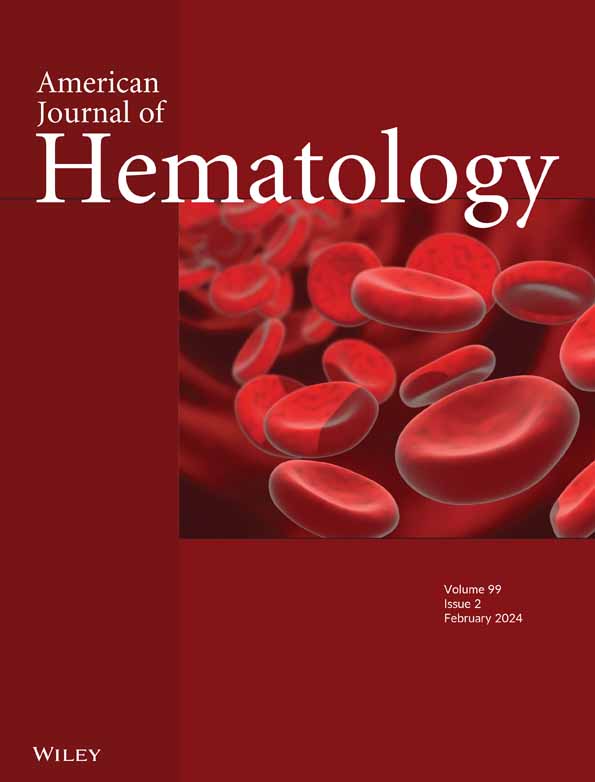细胞减少对高疾病负担复发或难治性B-ALL患者布纳单抗治疗结果的影响
IF 9.9
1区 医学
Q1 HEMATOLOGY
引用次数: 0
摘要
Blinatumomab被批准用于治疗复发或难治性(R/R) b细胞急性淋巴细胞白血病(B-ALL)。研究表明,布利纳单抗前高疾病负担(HDB)[50%骨髓母细胞(BMB)]与较低的应答率和毒性风险增加相关,包括细胞因子释放综合征(CRS)和神经毒性(NT)。虽然blinatumumab前的细胞减少治疗是一种吸引人的方法,但缺乏验证该策略在HDB患者中的有益效果的大型研究。我们回顾性分析了148例接受blinatumumab治疗的R/R B-ALL成年患者。患者分为低疾病负担组(LDB, n = 55)、未细胞减少组(n = 41)和细胞减少组(n = 52)。该队列的中位年龄为40岁;大多数为男性(63%)和西班牙裔(73%),最常见的ALL亚型为ph样(40%)。与其他队列相比,伴有细胞减少的HDB患者具有更高的先前同种异体hct率(p = 0.041)和更多的先前治疗线(p = 0.006)。与HDB患者相比,LDB患者对blinatumumab的应答率显著高于HDB患者(p < 0.0001),而CRS和NT的发生率无显著差异。在HDB患者中,与未接受细胞减少治疗的患者相比,细胞减少治疗与CRS发生率显著降低相关(p = 0.038)。然而,细胞减少对治疗反应、MRD阴性或NT没有显著影响。B-ALL和HDB患者仍然是布利纳单抗治疗的一个具有挑战性的人群;虽然细胞减少可以通过降低CRS来提高安全性,但需要新的策略来提高治疗效果。本文章由计算机程序翻译,如有差异,请以英文原文为准。
The Impact of Cytoreduction on Blinatumomab Outcomes for Relapsed or Refractory B-ALL With High Disease Burden.
Blinatumomab is approved for the treatment of relapsed or refractory (R/R) B-cell acute lymphoblastic leukemia (B-ALL). Studies have correlated pre-blinatumomab high disease burden (HDB) [> 50% bone marrow blasts (BMB)] with lower response rates and increased risk for toxicities, including cytokine release syndrome (CRS) and neurotoxicity (NT). While the administration of pre-blinatumomab cytoreductive therapy is an appealing approach, larger studies validating the beneficial effect of this strategy in patients with HDB are lacking. We retrospectively analyzed 148 adult patients with R/R B-ALL treated with blinatumomab. Patients were grouped as low disease burden (LDB, n = 55), HDB without cytoreduction (n = 41), and HDB with cytoreduction (n = 52). The median age for the cohort was 40 years; the majority were males (63%) and Hispanic (73%), and the most common ALL subtype was Ph-like (40%). Patients with HDB with cytoreduction had a significantly higher rate of prior alloHCT (p = 0.041) and more lines of prior therapy (p = 0.006) compared to the other cohorts. Compared to patients with HDB, those with LDB had significantly higher response rates to blinatumomab (p < 0.0001), while rates of CRS and NT were not significantly different. Among patients with HDB, cytoreductive therapy was associated with a significantly lower rate of CRS compared to those who did not receive cytoreduction (p = 0.038). However, cytoreduction had no significant impact on treatment response, MRD negativity, or NT. Patients with B-ALL and HDB remain a challenging population for blinatumomab therapy; while cytoreduction may improve safety by reducing CRS, novel strategies are needed to enhance treatment efficacy.
求助全文
通过发布文献求助,成功后即可免费获取论文全文。
去求助
来源期刊
CiteScore
15.70
自引率
3.90%
发文量
363
审稿时长
3-6 weeks
期刊介绍:
The American Journal of Hematology offers extensive coverage of experimental and clinical aspects of blood diseases in humans and animal models. The journal publishes original contributions in both non-malignant and malignant hematological diseases, encompassing clinical and basic studies in areas such as hemostasis, thrombosis, immunology, blood banking, and stem cell biology. Clinical translational reports highlighting innovative therapeutic approaches for the diagnosis and treatment of hematological diseases are actively encouraged.The American Journal of Hematology features regular original laboratory and clinical research articles, brief research reports, critical reviews, images in hematology, as well as letters and correspondence.

 求助内容:
求助内容: 应助结果提醒方式:
应助结果提醒方式:


